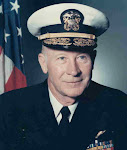
On 13 June 1944 our air group was launched with fighters, dive bombers and torpedo planes to hit the Agana and Orate alrfie1ds at Guam. Strike CAG-2 Lt. Cdr. J. D. Arnold with wing man Ens. Donald C. Brandt were flying F6F-3's (0930). As we pushed over in a bombing run anti-aircraft fire intensified and Ens. Brandt's plane was hit almost immediately with smoke pouring out. As he opened the canopy with the plane headed for Agana Bay I called to tell him not to ball out yet (I didn’t think ke could make it to the bay and to parachute to the land area meant capture and death-- we had been briefed that the Japanese were taking no prisoners with beheading the most likely result). In the next minute he left the plane while nosed over in a fast dive and the parachute snapped open. The wind carried him towards the bay, and several of us started to strafe the beach where it was apparent he was going to land about 500 yards off shore.
I called the life guard submarine STINGRAY which was supposed to be station off the harbor entrance. (Skipper of the sub was Lt. Cdr Sam Loomis). Realizing the sub might be attacked, I called for dive bombers to hit AA positions along the harbor entrance and for all fighters with ammunition remaining to set up a strafing circle and to take out the boat which was departing 'the beach and heading for Brandt’s raft which he had managed to crawl into.
(1230) With ammunition gone, I headed back to the ship to refuel and rearm so we could keep the shore batteries busy so they wouldn’t have time to shoot at Ens. Brandt. Meantime the wind was pushing him away from the beach. We were hoping that the wind would take Brandt toward the bay entrance. At about 1430 we returned from the HORNET rearmed, and commenced runs on the beach and the dive bombers on shore gun positions. At this point, I was cussing the skipper of the sub for lack of action. As I flew low over Brandt in his raft, I noticed he seemed to be moving faster than the wind would ordinarily propel him -- a second pass and the reason was apparent -- he had secured his raft to the sub's periscope with a line and was being towed towards the harbor entrance. It was more important than ever that we
- 1 –
silence all guns in the area, and that we did. At about 1630 the STINGRAY surfaced and took Ens. Brandt aboard.
I learned later that after our troops landed on Guam in August 1941~, a diary was recovered from a dead Japanese soldier. On the afternoon of 13 June 1944 the soldier had watched Ens. Brandt’s rescue and had written down these impressions: “The Americans are very stupid. They risk a submarine for one man. I think they have very foolish minds>’
This memo was hand typed by Admiral Arnold and OCR’d for this posting.



No comments:
Post a Comment